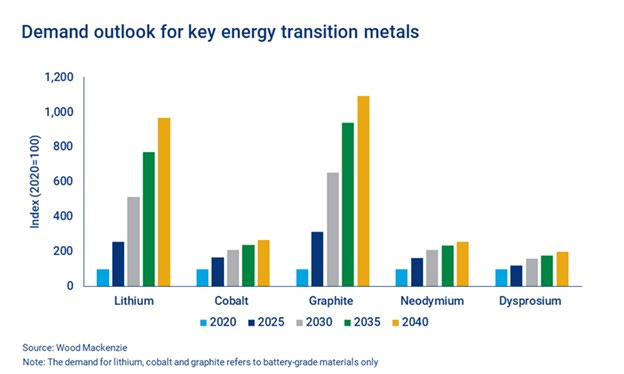You are Materials Blind.
It's not your fault. You live in a throwaway society.
“I can’t see anything, but this place seems familiar.”
Photo by David Underland on Unsplash
I wrote about Energy Blindness in this space recently to point out that the energy inputs needed to make an economy go are often left out of our economic models. Most specifically, energy is conspicuously absent from the production function of q = f(K,L) where the output (q), depends only on the capital you put in (K) and labor (L).
There is another variable that is often left out of this discussion, the materials needed to produce everything in our civilization. When we are holding, eating, or using anything, we very rarely think of where that item came from and how the materials used to make it impact our environment.
Think of concrete, steel, copper, aluminum, timber, water, and all the resources that we use in the modern world. Now think of the planetary boundaries framework, and remember that we have pushed past 6 of the planetary boundaries, with ocean acidification likely to be crossed in the next decade or so.
Then flip through the UN Environment Programme Global Resources Outlook Report that came out earlier this year. The report states that without urgent and concerted action to decrease resource use, by 2060 resource extraction could rise by 60% from 2020 levels.
That is 60% more materials used than we use today in about 35 years time.
Here are some other highlights of the report.
1. Material use has increased more than three times over the last 50 years. It continues to grow by an average of more than 2.3% per year.
2. Climate and biodiversity impacts from material extraction and processing greatly exceed targets based on staying within 1.5° of climate change and avoiding biodiversity loss.
3. High-income countries use six times more materials per capita and are responsible for 10 times more climate impacts per capita than low-income countries
4. Compared to historical trends it is possible to reduce resource use while growing the economy, reducing inequality, improving well-being, and dramatically reducing environmental impacts.
5. Speed up responsible and innovative ways of meeting human needs and promote social acceptance of the necessary transitions.
6. The prevailing approach we're focusing almost exclusively on the supply side(production) measures must be supplemented with a much stronger focus on the demand side (consumption) measures.
7. The scientific community is united around the urgency of resolute action and bold evidence-based decisions that protect the interests and well-being of all including future generations.
The word degrowth isn’t mentioned in the report once, but as you can see, there are some solid degrowth principles in there. Reduced resource use, reduced inequality, improved well-being, reduced environmental impact, innovative ways to meet human needs, focus on the demand side of the supply/demand equation, and more.
Degrowth is slowly creeping into the conversation if not expressly named.
A circular economy would be great, but we aren’t there.
If you think we will surely have a more circular economy by then in which we use things more efficiently, and reuse them – I hope you are right, but the trends say otherwise.
According to the recent Circularity Gap Report 2024, the circular economy has increased in the number of discussions, and debates as articles on circularity have nearly tripled over the past five years. That is the good news. However, the share of secondary materials consumed by the global economy has decreased from 9.1% in 2018 to 7.2% in 2023 or a 21% drop in the last five years. At the same time, consumption accelerates. Over that same five-year period, humanity has consumed over 500 gigatons of materials. To put that in perspective, 500 gigatons is 28% of all the materials humanity has consumed since 1900.
It is clear that we need to pay attention to the materials we use in our lives and be better stewards of our resources.
But those discussions largely aren’t happening.
Don’t worry, green energy will save us. Just don’t talk about the material footprint.
The economist had a great story recently on the explosion in the use of solar energy and how solar energy is already and will continue to revolutionize the world. I’m sure they are right. But nearly the whole article focused on the wonderful ways that solar power can meet our growing energy needs. There were a few sentences about the increase in resource use and the problem of Jevon’s Paradox, but these were quickly dismissed.
But they can’t be dismissed. We are already well beyond overshoot in 6 of 9 planetary boundaries. It is good to know that there is a clean technology that will power our growth in the coming decades. However, there is almost no discussion of whether that growth is desirable when our current circumstances seem to show that it is not.
A solar ramp-up that the Economist is talking about would lead to explosive increases in the mining of rare earth minerals for battery storage. In 2022, Simon Michaux, the senior scientist at the Geological Survey of Finland, published a detailed study of the metals required to phase out fossil fuels in favor of renewables. Michaux shows that we would need a revolution in mining to get to many of these materials. For solar panels, these materials are mostly silicon, which is plentiful enough in the amounts needed, and copper, which is not.
Look at the below chart which shows the astronomical increases in lithium and graphite that will be needed for the batteries and other equipment to swap out green energy for fossil fuels, and keep growing while we do it. All that mining requires energy, destroys land and habitat, and leads to future growth (Jevon’s rebound effect).
Wouldn’t it be easier to just not obsess over growth and choose a better path?
We can get lots of these metals and minerals, by destroying the ocean just a little bit more.
There are currently discussions to start mining the ocean floor because there are nodules of needed metals and minerals there that have been forming for millions of years. The companies looking to do this mining say they can do so with minimal disruption to the seabed floor. Does anyone believe that?
The Clarion-Clipperton Zone (CCZ) is an ocean plain in the Pacific Ocean between Mexico and Hawaii, that has mostly remained untouched by human activity. But it is rich in the nodules that we want to drive our green energy revolution.
Surveyors expect the overall tonnage across the CCZ to be substantial, in some cases higher than the sources now mined on land.
The nodules are part of the ocean floor ecosystem, as they are safe places for microbes and sponges to gather, which eventually brings other life to feed, hide, live, or lay eggs.
Whether this ecosystem is studied or exploited may depend on the International Seabed Authority (ISA). The ISA is a United Nations-affiliated agency responsible for the seemingly contradictory mandate of promoting deep-sea mining in international waters and protecting the ecosystems of the seafloor in those international waters. As of July 2023, the ISA has not issued any permits for mining and says it will not finalize regulations for deep-sea mining until 2025.
Is there a way out of this problem?
Well maybe.
Go back to those dismal numbers for circularity (less than 10% of our materials are reused or recycled). A recent initiative by the UN showed that we throw away more copper and cobalt than could currently be mined in the CCZ.
The United Nations has started monitoring e-waste. Its new “Global E-waste Monitor” showed that in 2022, the world threw out 62 million metric tons of electronics. The report includes a detailed breakdown of the metals present in our electronic garbage and how often they are being recycled – which is – not much.
So, we could do the responsible thing and recycle our e-waste and leave the CCZ alone, or we could dredge the ocean floor so we can destroy the more pristine natural habitat of life forms we know very little about so that we can grow and produce more e-waste.
What’s it going to be?




A clear & valuable summary state-of-the-planet sunopsis..BUT the demicratic deficit csn blow-out with global trumpism..look (& weep) at the deletion in 2024 of decades of hard-won basic environmental law protecting New Zealand waterways and biodiversity habitatat. In the mother of all policy bonfires. Why? To enable intensive dairying and mining of coal and "critical minerals" in our fragile River systems and marine continental shelf regions. This paradox of political lurch to extreme right as consumption or militarism -driven scarcity raises prices and needs a name. Like Overshoot Capitalism?